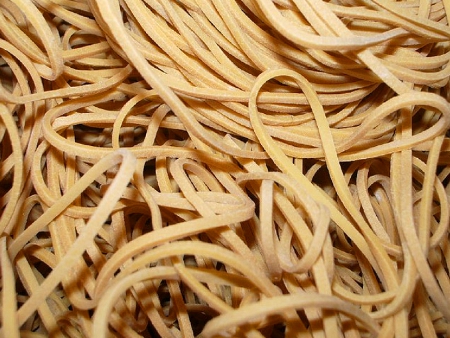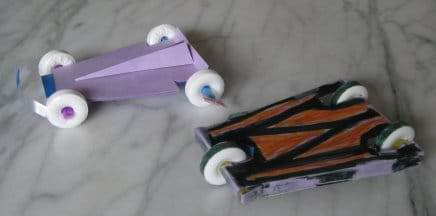Lesson: Rubber Band Racers

http://www.flickr.com/photos/altemark/ | CC 2.0
(Lesson courtesy of TryEngineering.org Click HERE for full lesson PDF)
In this activity, teams of students learn about engineering design by constructing rubber band-powered cars from everyday materials that can travel in a straight line for a distance of at least 3 meters within a 1 meter wide track. They test their rubber-band racers, evaluate their results, and present to the class.
Age Levels: 8 – 18
Time: Two or three 45-minute classes
Learning Outcomes
As a result of this activity, students will have:
- Designed and constructed a rubber band car
- Measured distance and calculated speed
- Tested and refined their designs
- Communicated their design process and results
ITEA National Study of Technology Content Standards:
- The Nature of Technology (1, 2)
- Design (8, 9, 10)
- Abilities for a Technological World (11, 12)
- The Designed World (16)
National Science Education Standards:
- Content Standard A, Science as Inquiry. As a result of these activities, students should develop abilities necessary to do scientific inquiry (K-12)
- Content Standard B, Physical Science. Students shall develop an understanding of properties of objects and materials (K-4); motions and forces (5 -12).
- Content Standard F, Science in Personal and Social Perspective. Risks and benefits; science and technology in society (5-8)
- Content Standard G: History and Nature of Science. Science as human endeavor (K-4); history of science (9 -12).
Massachusetts Curriculum Frameworks, Science and Technology/Engineering Standards:
- Materials & Tool (1.1, 1.2, 1.3)
- Engineering Design (Grades 3 -5: 2.2, 2.3; Grades 6 -8: 2.1, 2.2., 2.3, 2.4)
- Physical Science (1, 4, 5)
Lesson Activities
In “Rubber-Band Racers,” students explore rubber-band car design. Whey work in teams of “engineers” to design and build their own rubber-band car out of everyday items. They test their rubber band cars, evaluate their results, and present to the class.
Resources/Materials
For each group of students:
- 16 in. x 16 in. sheet of corrugated cardboard (cereal box or smaller piece of cardboard can be used)
- Four CDs, paper plates, or plastic lids from yogurt, coffee or takeout food.
- 4 rubber bands
- 3 unsharpened pencils
- 4 paper clips
- 1 box thumb tacks
- Scissors
- Masking tape
- Meter or yardstick
- Stop watch
- Student worksheets
Procedure
1. Show students the various Student Reference Sheets. These may be read in class or provided as reading material for the prior night’s homework.
2. Divide students into groups of 3 or 4 students, providing each group a set of materials.
3. Explain that students must develop a car powered by rubber bands from everyday items, and that the rubber band car must be able to travel a distance of at least 3 meters within a 1 meter wide track. Rubber bands cannot be used to slingshot the cars. The car that can travel within the track for the greatest distance is the winner.
4. Students meet and develop a plan for their rubber-band car. They agree on materials they will need, write or draw their plan, and then present their plan to the class.
5. Student teams may trade unlimited materials with other teams to develop their ideal parts list.
6. Next, student groups execute their plans. They may need to rethink their plan, request other materials, trade with other teams, or start over.
7. Finally….teams will test their rubber band car. Students can create the 1 meter wide “track” using masking tape on the floor.
8. Teams then complete an evaluation/reflection worksheet, and present their findings to the class.

- Student Resource Sheets (pages 4 – 5 of this .pdf includes history of the automobile and Newton’s laws)
- Student Worksheets (pages 6 -9 in the .pdf)
Additional teacher and student resources:
How to build a rubber-band car from cardboard and old CDs, from PBS Design Squad.
How to build a rubber-band car, courtesy of malasiaminilover.com. Step-by-step instructions with illustrations.
Step-by-step instructions for making a rubber-band-powered car (illustration) that uses two CDs for wheels, student handout, and illustrated leader notes for PBS Design Squad Nation’s Rubber-Band Car Challenge. (For 9- to 12-year-olds.) Watch a demo.
Videos from SAE International’s A World In Motion Jet-Toy challenge. (Read how teachers nationwide are using free A World In Motion kits in this 2009 article in ASEE’s Prism magazine.)
Popular Mechanics article detailing how Mythbusters discovered electric go karts are faster than gas-powered models.
Extra credit:
Mint-Mobiles. In this 50-minute TeachEngineering.org activity, students in grades 3 – 5 make race cars from straws, lifesaver-shaped candy wheels, and cardboard, then test them with various loads of pennies.
How to Build a Low-Cost, Green Go Kart. Step-by-step advice and illustrations from Winston-Salem/Forsyth County Schools’ Career Center teacher William Longwood.
Filed under: Grades 6-8, Grades K-5, Lesson Plans
Tags: Class Activities, force, Grades 6-8, Grades K-5, Lesson Plan, Lesson Plans, motion, Physics, propulsion, rubber band racers










